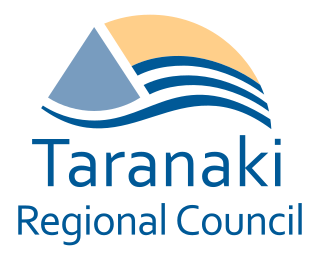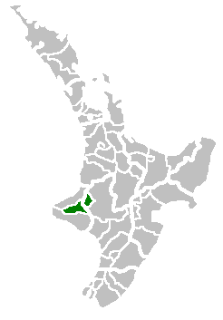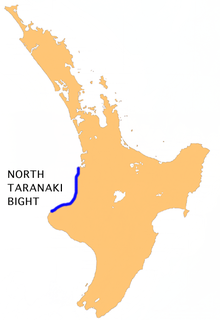
The source of the Waitara River lies in the very steep hill country to the east of Mount Taranaki/Egmont, near Tahora. After proceeding in a southwesterly direction toward Central Taranaki, the river abruptly turns to flow in a northwesterly direction to the Tasman Sea: meeting it at the coastal town of Waitara. [1]

Tahora is a small settlement located in the Manawatu-Wanganui Region in the North Island of New Zealand along the Stratford–Okahukura railway line and State Highway 43 between Stratford and Taumarunui. It was the location of an annual folk music festival for 30 years.

Taranaki is a region in the west of New Zealand's North Island. It is named after its main geographical feature, the stratovolcano of Mount Taranaki.

The Tasman Sea is a marginal sea of the South Pacific Ocean, situated between Australia and New Zealand. It measures about 2,000 km (1,200 mi) across and about 2,800 km (1,700 mi) from north to south. The sea was named after the Dutch explorer Abel Janszoon Tasman, who was the first recorded European to encounter New Zealand and Tasmania. British explorer Captain James Cook later extensively navigated the Tasman Sea in the 1770s as part of his first voyage of exploration.
Contents
The river once had a dock in Waitara, where export meat from the town's Thos. Borthwick & Sons freezing-works was loaded onto ships. However, this trade was subsequently conducted from New Plymouth's Port Taranaki until the works closed in 1995.

Waitara is a town in the northern part of the Taranaki region of the North Island of New Zealand. Waitara is located just off State Highway 3, 15 kilometres (9.3 mi) northeast of New Plymouth. Its population was 6312 in the 2013 census, an increase of 24 from 2006.

New Plymouth is the major city of the Taranaki Region on the west coast of the North Island of New Zealand. It is named after the English city of Plymouth from where the first English settlers migrated. The New Plymouth District, which includes New Plymouth City and several smaller towns, is the 10th largest district in New Zealand, and has a population of 74,184 – about two-thirds of the total population of the Taranaki Region and 1.7% of New Zealand's population. This includes New Plymouth City (58,300), Waitara (6,483), Inglewood (3,380), Oakura (1,359), Okato (561) and Urenui (429).

Port Taranaki is a port complex located in New Plymouth, New Zealand. It is the only deep water port on the west coast of New Zealand, and is owned by the Taranaki Regional Council. The port handles a wide range of coastal and international cargoes, mostly relating to the farming, engineering and petrochemical industries. Shipping volumes decreased significantly over the period 2012 to 2015.
The Waitara is the first mud-bottomed river to the north of Cape Egmont. It is prone to flooding, and there are stop banks (levees) to the west of the river (upstream from the bridge) and on both sides downstream.

Cape Egmont, splitting Northern and Southern Taranaki Bights, is the westernmost point of Taranaki, on the west coast of New Zealand's North Island. It is located close to the volcanic cone of Mount Taranaki or Mount Egmont. It was named Kaap Pieter Boreel by Dutch explorer Abel Tasman in 1642, but renamed Cape Egmont by British explorer James Cook in 1769.. Ironically, the cape retained a Dutch name, as Cook named the mountain and cape after the Earl of Egmont, who claimed descent of the Dutch House of Egmond.
The historic Bertrand Road suspension bridge, (one of only a few such road bridges in New Zealand) is several kilometres from State Highway 3 (just up from the town).

The Bertrand Road suspension bridge crosses the Waitara River, linking Huirangi, near Lepperton and Tikorangi in north Taranaki, New Zealand. The original bridge was built in 1897, and rebuilt in 1927.

State Highway 3 (SH 3) is one of New Zealand's eight national state highways. It serves the west coast of the country's North Island and forms a link between State Highway 1 and State Highway 2. Distances are measured from north to south.







